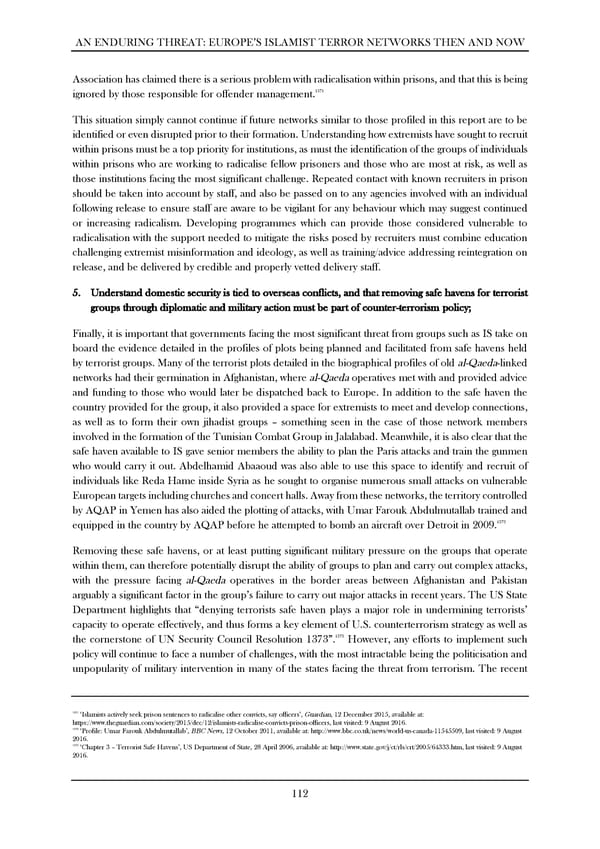AN ENDURING THREAT: EUROPE’S ISLAMIST TERROR NETWORKS THEN AND NOW Association has claimed there is a serious problem with radicalisation within prisons, and that this is being 1371 ignored by those responsible for offender management. This situation simply cannot continue if future networks similar to those profiled in this report are to be identified or even disrupted prior to their formation. Understanding how extremists have sought to recruit within prisons must be a top priority for institutions, as must the identification of the groups of individuals within prisons who are working to radicalise fellow prisoners and those who are most at risk, as well as those institutions facing the most significant challenge. Repeated contact with known recruiters in prison should be taken into account by staff, and also be passed on to any agencies involved with an individual following release to ensure staff are aware to be vigilant for any behaviour which may suggest continued or increasing radicalism. Developing programmes which can provide those considered vulnerable to radicalisation with the support needed to mitigate the risks posed by recruiters must combine education challenging extremist misinformation and ideology, as well as training/advice addressing reintegration on release, and be delivered by credible and properly vetted delivery staff. 5. Understand domestic security is tied to overseas conflicts, and that removing safe havens for terrorist ! groups through diplomatic and military action must be part of counter-terrorism policy; Finally, it is important that governments facing the most significant threat from groups such as IS take on board the evidence detailed in the profiles of plots being planned and facilitated from safe havens held by terrorist groups. Many of the terrorist plots detailed in the biographical profiles of old al-Qaeda-linked networks had their germination in Afghanistan, where al-Qaeda operatives met with and provided advice and funding to those who would later be dispatched back to Europe. In addition to the safe haven the country provided for the group, it also provided a space for extremists to meet and develop connections, as well as to form their own jihadist groups – something seen in the case of those network members involved in the formation of the Tunisian Combat Group in Jalalabad. Meanwhile, it is also clear that the safe haven available to IS gave senior members the ability to plan the Paris attacks and train the gunmen who would carry it out. Abdelhamid Abaaoud was also able to use this space to identify and recruit of individuals like Reda Hame inside Syria as he sought to organise numerous small attacks on vulnerable European targets including churches and concert halls. Away from these networks, the territory controlled by AQAP in Yemen has also aided the plotting of attacks, with Umar Farouk Abdulmutallab trained and 1372 equipped in the country by AQAP before he attempted to bomb an aircraft over Detroit in 2009. Removing these safe havens, or at least putting significant military pressure on the groups that operate within them, can therefore potentially disrupt the ability of groups to plan and carry out complex attacks, with the pressure facing al-Qaeda operatives in the border areas between Afghanistan and Pakistan arguably a significant factor in the group’s failure to carry out major attacks in recent years. The US State Department highlights that “denying terrorists safe haven plays a major role in undermining terrorists’ capacity to operate effectively, and thus forms a key element of U.S. counterterrorism strategy as well as 1373 the cornerstone of UN Security Council Resolution 1373”. However, any efforts to implement such policy will continue to face a number of challenges, with the most intractable being the politicisation and unpopularity of military intervention in many of the states facing the threat from terrorism. The recent ! ! 1371 ‘Islamists actively seek prison sentences to radicalise other convicts, say officers’, Guardian, 12 December 2015, available at: https://www.theguardian.com/society/2015/dec/12/islamists-radicalise-convicts-prison-officers, last visited: 9 August 2016. 1372 ‘Profile: Umar Farouk Abdulmutallab’, BBC News, 12 October 2011, available at: http://www.bbc.co.uk/news/world-us-canada-11545509, last visited: 9 August 2016. 1373 ‘Chapter 3 – Terrorist Safe Havens’, US Department of State, 28 April 2006, available at: http://www.state.gov/j/ct/rls/crt/2005/64333.htm, last visited: 9 August 2016. ! ! 112 !
 An Enduring Threat: Europe’s Islamist Terror Networks Then and Now Page 117 Page 119
An Enduring Threat: Europe’s Islamist Terror Networks Then and Now Page 117 Page 119